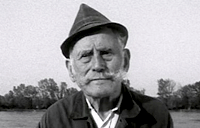An elderly cemetery caretaker, Josef Fuchs, impassively looks out into the Danube River before turning to face the camera and reciting Count Albrecht Graf Wickenburg’s requiem for the namenlos – the unidentified dead, often people who committed suicide or lost their lives in boating accidents, whose bodies have washed up along the riverbank over the years and were buried at the Cemetery of the Nameless in lower Austria near the city limits of Vienna. In another area along the Danube River, a military guard stands atop an outpost scanning the landscape amidst the rumble of a hydroelectric plant overlooking a pedestrian bridge as vehicles speed past across a road on the opposite side of the river. In still other images of the Danube itself, a floating, ceremonial casket covered with flowers drifts aimlessly with the current towards its indeterminate place of rest, and a lone angler watches the tranquil waters for signs of activity as he rows his boat along the river in search of an ideal fishing spot. These introductory parallel images of disparate, yet intrinsically connected river sentinels along the Danube provides the framework for Nikolaus Geyrhalter’s evocative and understated stream of consciousness rumination, Washed Ashore, an interweaving elegy on ritual and obsolescence set against the eternal, yet indelibly transforming modern day, socioeconomic landscape of the river in the face of encroaching urbanization, a collapsed Soviet bloc economy, and globalization.
This paradoxical coexistence of construction and erosion, activity and decline that characterizes contemporary life along the Danube is initially reflected through Fuchs’s own testimony of his evolving role in the cemetery since the site’s incorporation into the city of Vienna during the early half of the twentieth century. Decades earlier, during the final years of regional autonomy from Viennese jurisdiction when the laws still permitted people to trawl bodies found floating on the river, he had retrieved as many as fifty unclaimed corpses for burial. Now prohibited by the district charter from recovering the dead from the river (a phenomenon that would also be mitigated by the implemented diversion of the river, perhaps to feed the hydroelectric plant and prevent soil erosion that will accommodate new construction along the riverbank), the aging Fuchs now single-handedly tends to the care and maintenance of the existing (and now largely representational) anonymous graves, often faced with exhausting responsibilities of controlling overgrown foliage, grounds keeping, and even repairing markers and placards that have been defaced by thrill-seeking vandals and souvenir hunters from the gravesites. A similar sentiment of a dying way of life is intimated in the fisherman’s explanation of the local community’s opposition to the assimilation of the area’s natural attractions into a proposed national park, arguing that such a project would not only open the floodgates to large-scale tourism that will adversely affect the area’s already fragile ecological balance, but also, as a consequence, lead to the imposition of even more stringent regulations that will threaten their very livelihood.
However, the vulnerability of integral economies enabled by the river cannot be not solely attributed to the problems of (over) development, as illustrated by the middle-aged husband and wife team of barge operators from Romania, Aurel and Helene Rotaru, who live modestly aboard their company-supplied boat transporting industrial goods and raw materials bound for harbors along the Danube throughout Europe. Nearing retirement, the couple sees their lifelong career as a dying vocation, as younger generations, raised in an age of modern conveniences and discotheques, are unable to adapt to the more old fashioned (and decidedly low tech) lifestyle demanded by their nomadic occupation. This sense of self-imposed simplicity and asceticism is perhaps best illustrated by Gyosei Masunaga, a Buddhist monk who, years earlier, heeded the teachings of his mentor and left Japan to establish a peace pagoda and temple in Vienna in order to commemorate the bombing of Hiroshima and Nagasaki, and now leads a humble life of devotion and subsistence near the riverbank. Closing with the rhapsodic performance of an untranslated traditional folksong by a traveling musician (Polina Schestova), her soulful performance serves as an idiosyncratically fitting coda to Geyrhalter’s organic symphony on the enduring mutability of life along the margins of the Danube itself – at once, exotic and familiar, somber and rapturous, distant and transcendable.
© Acquarello 2007. All rights reserved.
